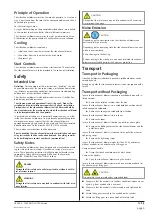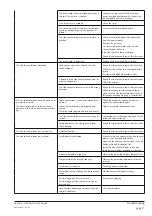
●
Connect the suction line
Installation without suction line:
◆
Make sure that the gas inlet (e) is open
●
Connect the discharge line
or
●
Connect the pressure line
Installation without discharge line:
◆
Make sure that the gas discharge (d) is open
●
Make sure that all provided covers, guards, hoods etc. are
mounted
●
Make sure that cooling air inlets and outlets are not covered or ob-
structed and that the cooling air flow is not affected adversely in
any other way
In case the side channel blower comes with an eyebolt for the attach-
ment of lifting gear:
◆
Make sure that the eyebolt is firmly tightened
Recording of Operational Parameters
As soon as the side channel blower is operated under normal operating
conditions:
●
Measure the drive motor current and record it as reference for fu-
ture maintenance and troubleshooting work
Operation Notes
Use
WARNING
_ad
The
side channel blower
is designed for operation under the
condi-tions described below.
In case of disregard risk of explosion!
The
side channel blower
must only be operated under the condi-
tions described below.
WARNING
_ad
Operating a faulty side channel blower puts the explosion safety at
risk.
Risk of explosion!
The side channel blower must only be operated in faultless condi-
tion. A faulty side channel blower must immediately be removed
from service.
The side channel blower is intended for
–
the suction
–
the compression
of
–
mixtures of dry non-aggressive and non-toxic gases and/or dust
according to the identification on the nameplate of the side
channel blower (explanation see below)
Installation and Commissioning
SB 0050 - 1400 D0/D2
ATEX-Version
0870145236
/
181122
page 7
WARNING
_ad
/PERATINGWITHVARIABLEFREQUENCYDRIVE
2ISKOFINJURYØ
2ISKOFDAMAGETOTHEMACHINEØ
/NLYUSEVARIABLEFREQUENCYDRIVEINACCORDANCEWITH
ACCOMPANYINGINSPECTIONDOCUMENTFORINVERTERFEDEXPLOSION
PROOFMOTORS
Conveying media with a lower or higher density than air leads to an in-
creased thermal and/or mechanical load on the
side channel blower
and is permissible only after prior consultation with Busch.
According to the directive
/E
5
(“ATEX
”) the
side
channel
blower
is made for the intended use in potentially explosive
areas ac-cording to the data given on the nameplate of the
side
channel
blower
and on the data given on the nameplate of the drive
motor.
The classification on the
side channel blower
is to be read as follows
(interpretations of equipment categories and zones for information
only; the relevant laws, directives and standards are literally binding;
for temperature classes and explosion groups see E. Brandes, W. Möller
“Sicherheitstechnische Kenngrößen, Band 1: Brennbare Flüssigkeiten
und Gase”, ISBN 3-89701-745-8 (or equivalent source)):
If the classifications with regard to the conveyed gas/air or dust/air
mixture on the one side and the environment of the
side channel
blower
on the other side vary, the nameplate of the
side channel
blower
reads the classification with regard to the conveyed gas/air or
dust/air mixture first and next, after a slash, the classification with re-
gard to the environment (example “3/2”).
II 3/2G c T3
Group II, for non-mining applications,
explosive atmosphere consisting of a mixture with air of flammable
substances in the form of gas in the process gas not likely to occur in
normal operation but, if it does occur, will persist for a short period
only (equipment category 3, for zone 2),
in the environment explosive atmosphere consisting of a mixture with
air of flammable substances in the form of gas, vapour or mist likely to
occur in normal operation occasionally (equipment category 2, for
zone 1),
type of protection constructional safety,
for gases temperature class T3 in the process gas and in the environ-
ment.
Not for potentially explosive dust/air atmospheres.
II 3/2D c T 125°C
Group II, for non-mining applications,
in the process gas explosive atmosphere in the form of a cloud of com-
bustible dust in air not likely to occur in normal operation but, if it does
occur, will persist for a short period only (equipment category 3, for
zone 22),
in the environment explosive atmosphere in the form of a cloud of
combustible dust in air likely to occur in normal operation occasionally
(equipment category 2, for zone 21),
type of protection constructional safety,
maximum permissible surface temperature for the dust/air mixtures in
the process gas and in the environment greater equal 125 °C (acc. to
EN 50281-2-1 or IEC 61241-2-1 resp.).
Not for potentially explosive gas atmospheres.
II 3G T3
Group II, for non-mining applications,
in the process gas and in the environment explosive atmosphere con-
sisting of a mixture with air of flammable substances in the form of gas
(in the environment also vapour or mist) not likely to occur in normal
operation but, if it does occur, will persist for a short period only
(equipment category 3, for zone 2),
for gases temperature class T3 in the process gas and in the environ-
ment.
Not for potentially explosive dust/air atmospheres.
7HENUSINGMACHINESWITHVARIABLEFREQUENCYDRIVESTHE
MAXIMUMROTATIONSPEEDWRITTENONTHENAMEPLATEMUSTBE
ADHEREDTO
Connecting Lines/Pipes
●
Determine the intended direction of rotation with the arrow (stuck
on or cast)
●
“Bump” the drive motor
●
Watch the fan wheel of the drive motor and determine the direc-
tion of rotation just before the fan wheel stops
If the rotation must be changed:
◆
Switch any two of the drive motor wires


































